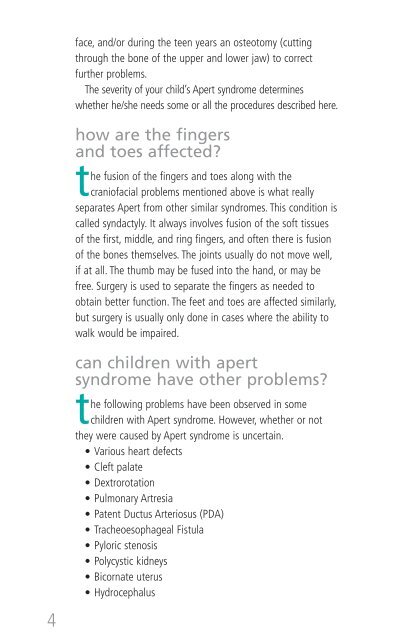A Guide to Understanding Apert Syndrome - Children's Craniofacial ...
A Guide to Understanding Apert Syndrome - Children's Craniofacial ...
A Guide to Understanding Apert Syndrome - Children's Craniofacial ...
Create successful ePaper yourself
Turn your PDF publications into a flip-book with our unique Google optimized e-Paper software.
face, and/or during the teen years an osteo<strong>to</strong>my (cuttingthrough the bone of the upper and lower jaw) <strong>to</strong> correctfurther problems.The severity of your child’s <strong>Apert</strong> syndrome determineswhether he/she needs some or all the procedures described here.how are the fingersand <strong>to</strong>es affected?the fusion of the fingers and <strong>to</strong>es along with thecraniofacial problems mentioned above is what reallyseparates <strong>Apert</strong> from other similar syndromes. This condition iscalled syndactyly. It always involves fusion of the soft tissuesof the first, middle, and ring fingers, and often there is fusionof the bones themselves. The joints usually do not move well,if at all. The thumb may be fused in<strong>to</strong> the hand, or may befree. Surgery is used <strong>to</strong> separate the fingers as needed <strong>to</strong>obtain better function. The feet and <strong>to</strong>es are affected similarly,but surgery is usually only done in cases where the ability <strong>to</strong>walk would be impaired.can children with apertsyndrome have other problems?4the following problems have been observed in somechildren with <strong>Apert</strong> syndrome. However, whether or notthey were caused by <strong>Apert</strong> syndrome is uncertain.• Various heart defects• Cleft palate• Dextrorotation• Pulmonary Artresia• Patent Ductus Arteriosus (PDA)• Tracheoesophageal Fistula• Pyloric stenosis• Polycystic kidneys• Bicornate uterus• Hydrocephalus





